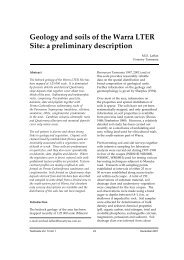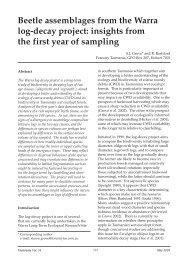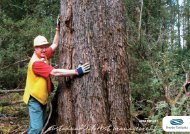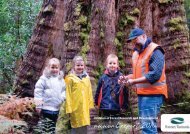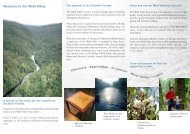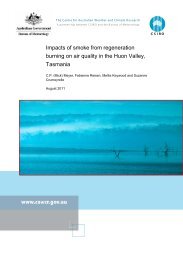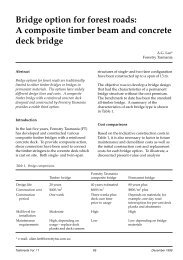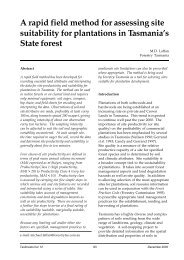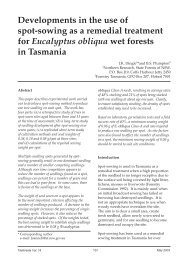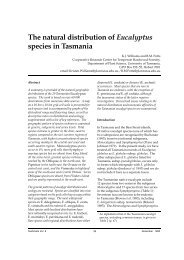annual report 2011 - Forestry Tasmania
annual report 2011 - Forestry Tasmania
annual report 2011 - Forestry Tasmania
You also want an ePaper? Increase the reach of your titles
YUMPU automatically turns print PDFs into web optimized ePapers that Google loves.
Biology and Conservation - Key research and development projects (continued)<br />
Sustainability Objective FT Staff and<br />
Collaborators<br />
Project name and aims 2010-11 Progress<br />
3. Sustaining carbon stores, clean air, water and healthy forests<br />
3.4 Weeds, pests and diseases<br />
Control weeds, pests and diseases<br />
to protect State forests.<br />
Avoid use and minimise risks of<br />
chemical control methods.<br />
T Wardlaw<br />
D Williams<br />
Collaborators<br />
University of<br />
<strong>Tasmania</strong>,<br />
Bushfire CRC,<br />
DPIPWE,<br />
University of<br />
Melbourne<br />
Browsing IPM<br />
Cost-effective management of browsing that<br />
seeks to capture maximum benefit from lowcost<br />
non-lethal options through integration with<br />
operational monitoring and culling.<br />
FT E. nitens seedlots screened (nursery and field) using near infrared<br />
spectroscopy to rank according to sideroxylonal levels. High and low<br />
sideroxylonal seedlots identified.<br />
Collaborated with CRC <strong>Forestry</strong>/UTas to develop experimental plan for<br />
demonstrator IPM (stockings + repellents + genetics with operational<br />
monitoring / culling) for establishment in spring <strong>2011</strong>.<br />
D Bashford<br />
N Ramsden<br />
Collaborators<br />
University of<br />
<strong>Tasmania</strong><br />
Sirex wood wasp<br />
Prevent significant losses from outbreaks of Sirex<br />
wood wasp in P. radiata plantations.<br />
Established and maintained static traps in five plantations and introduced<br />
nematodes into two plantations.<br />
Supervised post-doc and PhD in ARC-Linkage research project (Ips<br />
competition with Sirex in trap-trees).<br />
L Jordan<br />
T Wardlaw<br />
K Wotherspoon<br />
M Syme<br />
J Elek<br />
Collaborators<br />
University of<br />
<strong>Tasmania</strong>,<br />
CSIRO<br />
Sustainable<br />
Ecosystems,<br />
CRC <strong>Forestry</strong><br />
Leaf beetle management<br />
An IPM system that is efficient at preventing<br />
economic damage by leaf beetles in plantations.<br />
Co-ordinated 2010-11 leaf beetle IPM. The program monitored 29,000 ha of<br />
which 33% were above-threshold: nearly 5,800 ha were sprayed (96%with<br />
Dominex), natural population reductions were measured in 1,300 ha.<br />
Refined guidelines to make Spinsad simpler and cheaper to to use:<br />
incentive did not result in substantial increase in useage.<br />
Completed operational and financial analyis of the 2009-10 leaf beetle IPM<br />
and documented in a Technical Report.<br />
Collaborated with UTas Honours student conducting an study that related<br />
leaf beetle populations to site, climatic and landscape attributes. Simple<br />
risk model was developed.<br />
Commenced study to map spatial heterogenity of leaf beetle populations:<br />
three plantations spanning a range of population levels were mapped.<br />
Installed and monitored growth plots to measure the impact of defoliation<br />
on growth in mid-rotation plantations.<br />
Documented refinements to leaf beetle IPM: two key changes proposed –<br />
risk-based targeting of plantations to include in IPM; hybrid roadside OLPS<br />
monitoring.<br />
20




